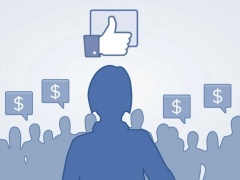2012 was a big year for Social Media – we saw some venues flourish, some flounder, and some explode with news distribution. It’s important for us to look at such statistics whether we’re seasoned Internet analysts or average users, so that we can stay on top of these fast-changing sites. Which were stars and what trends stood out the most? Let’s find out!
Statistics
 According to Huffington Post, in 2012 a staggering 1 million websites integrated Facebook as part of their Social Media stash. Even better for businesses, 80% of Facebook users prefered connecting with their favorite brands through Facebook and 23% of them checked their feeds five or more times a day, widening the door to better communication and more efficient customer service. [source]
According to Huffington Post, in 2012 a staggering 1 million websites integrated Facebook as part of their Social Media stash. Even better for businesses, 80% of Facebook users prefered connecting with their favorite brands through Facebook and 23% of them checked their feeds five or more times a day, widening the door to better communication and more efficient customer service. [source]
 Huffpost also saw some interesting numbers for Twitter which marketers should consider. A sizable 56% of Tweets from consumers to businesses were ignored, and while it can be impossible for larger companies to answer every message, it is indicative of how Twitter can fail as a customer service tool with users getting lost in the shuffle. [source]
Huffpost also saw some interesting numbers for Twitter which marketers should consider. A sizable 56% of Tweets from consumers to businesses were ignored, and while it can be impossible for larger companies to answer every message, it is indicative of how Twitter can fail as a customer service tool with users getting lost in the shuffle. [source]
 Google+ had some good and bad results from 2012, because while websites using that +1 button saw a 350% increase in traffic, a hefty 70% of users want to learn more about Google+ with only 40% actually using it. This tells us that many marketers don’t yet see the value of Google+, or that the sharing site itself isn’t quite user-friendly enough for companies. In terms of average consumption it fared very well; 625,000 people joined Google+ every day and the +1 button is hit 5 million times per day! [source]
Google+ had some good and bad results from 2012, because while websites using that +1 button saw a 350% increase in traffic, a hefty 70% of users want to learn more about Google+ with only 40% actually using it. This tells us that many marketers don’t yet see the value of Google+, or that the sharing site itself isn’t quite user-friendly enough for companies. In terms of average consumption it fared very well; 625,000 people joined Google+ every day and the +1 button is hit 5 million times per day! [source]
 Instagram saw booming growth, though they didn’t end 2012 with a bang. Traffic increased by 724% for this popular photo sharing service, and in 2012 an average of 5 million photos were uploaded every 24 hours, with 575 Likes and 81 comments every second. The most popular hash-tags according to Huffpost were #Love, #Instagood, #Me, #TBT, and #Cute, which indicate an overall positive environment for users. [source]
Instagram saw booming growth, though they didn’t end 2012 with a bang. Traffic increased by 724% for this popular photo sharing service, and in 2012 an average of 5 million photos were uploaded every 24 hours, with 575 Likes and 81 comments every second. The most popular hash-tags according to Huffpost were #Love, #Instagood, #Me, #TBT, and #Cute, which indicate an overall positive environment for users. [source]
 Interestingly for Pinterest, 80% of pins were repins which tells us that users spent more time on their feeds than on other sites looking for things to pin to their boards. We also learned that 50% of Pinterest users have children and 80% of them are women, which greatly defines the audience for businesses. Considering 57% of pins are food related, Pinterest would make an excellent tool for companies that are food-driven and speak to young mothers in 2013! [source]
Interestingly for Pinterest, 80% of pins were repins which tells us that users spent more time on their feeds than on other sites looking for things to pin to their boards. We also learned that 50% of Pinterest users have children and 80% of them are women, which greatly defines the audience for businesses. Considering 57% of pins are food related, Pinterest would make an excellent tool for companies that are food-driven and speak to young mothers in 2013! [source]
Trends
Looking back at 2012 for Twitter, they’ve packaged their trends and hot topics for us to review. The top two ‘Golden Tweets‘ came from President Obama Tweeting “Four More Years” during the 2012 Presidential Election, and from Justin Bieber Tweeting “RIP Avalanna. i love you” about a six year old fan who passed away from a rare illness. What makes them ‘Golden Tweets’ according to Twitter? They were the most re-tweeted messages of the entire year. The biggest conversations on Twitter, or the ‘Pulse of the Planet‘, were about the Summer Olympics, the Presidential Election, Superstorm Sandy, and much more – generated from the most Tweets, Re-Tweets, and general discussions. Twitter also has a neat set of events that they’ve coined ‘Only on Twitter‘, with unique events such as “Live, from Mars” in which NASA live-tweeted Curiosity’s adventure to Mars, and the London Olympics Live Pool Camera that gave users a rare view of the swimmers from below.
Twitter has also neatly presented their biggest hash-tag trends and categorized them into various topics such as Conversation Starters, Politics, Sports, and TV. In similar categories, their ‘New Voices‘ page lists the most popular newcomers to Twitter from television, sports, film, and more – with convenient Follow buttons for easy one-click connecting. Finally, Twitter partnered with Vizify.com to give you a personal look at your 2012 year on Twitter. Simply visit their site, download the app, log in, and voi la – you’ll receive a “stunning graphical bio that shows the best of you.”
Facebook has a less comprehensive 2012 review, but they still nicely display various categories and topics that trended heavily this past year. Showcasing memes, events, songs, movies, check-ins, books, politics, and more, clicking on a specific topic will show you the Facebook rank for different trends – all very similar to Twitter’s hottest trends. You can also see trends from all over the world, peeking into different cultures and comparing what was most talked about across the globe. Perhaps the most interesting aspect is their built-in ‘Your Year in Review‘ feature that, with one click, will show you your 20 biggest moments based on comments, Likes, photographs, and events. It’s much simpler to access than Twitter’s application, and more visually heavy, which some users prefer. Once you’ve had a look, you can hit the Share button and let all of your friends see what you were up to in 2012.
Googles Zeitgeist 2012 encompasses everything that was searched for using Google for 2012. Hot trending topics and searches were for Whitney Houston, Gangnam Style, Hurricane Sandy, One Direction, iPhone 5, Michael Phelps, the Olympics, and much more. Google, like Twitter and Facebook, neatly packaged these trends into various categories and ranked the most popular topics within. Because venues like Twitter, Tumblr, and Facebook can be sources of news that often pique interest and send users to search engines for more information, we can use Google as a highly informative window into the most interesting topics of 2012.
Summary
Overall what were the memorable trends across all sharing sites? The Election, the Olympics, Whitney Houston’s death, and Superstorm Sandy were some of 2012’s biggest hitters. It was a year like years past; driven by social and political movements, entertainment shockers and events, sports and world news – though it was unique in Social Media consumption and some sharing sites surprised us when they pulled ahead of the pack. You may wonder why you should pay attention to these trends and statistics when the year is dead and gone. The answer is quite simple – before you can be a Social Media Marketer, you have to be a Social Media lover, so look back at your own trends and the world’s sharing habits from 2012. These are the very patterns that will drive you and your organization through Social Media in 2013!



 According to
According to 








